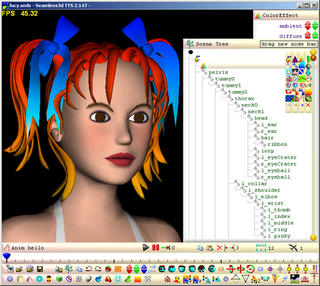Blaxxun Interactive, originally named "Black Sun Interactive", was one of the first companies to develop a 3D community platform designed for the Internet using VRML [1] and highly scalable multi-user server environments.
Blaxxun Interactive, originally named "Black Sun Interactive", was one of the first companies to develop a 3D community platform designed for the Internet using VRML [1] and highly scalable multi-user server environments.
Blaxxun was founded in August 1995 with its sales/marketing offices in San Francisco, CA and management/development in Munich, Germany. Blaxxun was funded by the US venture capital company CMGI, in the same portfolio as leading Internet companies like GeoCities and Lycos. Later blaxxun investors included tbg and General Electric.
Blaxxun developed various 3D browsers [2] and multi-user server platforms. Customers included BMW ("3D Car Configurator"), Deutsche Bank ("Virtual Shareholder Meeting"), IBM (3D Notebook Demo), Canal+ ("Virtual Paris"), Siemens, Intel, and many other major brands.
In 1996, Blaxxun acquired Cybertown, a US-based community and evolved it into a 3D community that attracted more than 1 million registered users by 2000. blaxxun also established joint ventures with Germany's leading publisher Cornelsen (3D community Learnetix) and the soccer community SoccerCity (in collaboration with Kicker magazine).[ citation needed ]
In 2000, Blaxxun was scheduled for an IPO [3] at Germany's Neuer Markt. The IPO was delayed and finally failed [4] in August 2000, when the Internet boom turned into the dot-com bubble. blaxxun's IPO consortium banks had a public disagreement about the cancellation, as the IPO was oversubscribed by a factor of 2.5 on the institutional side. [5] In 2001, blaxxun became shortly profitable and succeeded in raising more funding, but then was also hit by collapsing Internet revenues.
In early 2002, Blaxxun went out of business. Some assets were taken over by successor companies.
Blaxxun Technologies [6] continued to market the core server technologies. Bitmanagement Software [7] continued to develop the 3D client. Cybertown [8] was given back to the founders and was later sold.

VRML is a standard file format for representing 3-dimensional (3D) interactive vector graphics, designed particularly with the World Wide Web in mind. It has been superseded by X3D.
X3D is a set of royalty-free ISO/IEC standards for declaratively representing 3D computer graphics. X3D includes multiple graphics file formats, programming-language API definitions, and run-time specifications for both delivery and integration of interactive network-capable 3D data. X3D version 4.0 has been approved by Web3D Consortium, and is under final review by ISO/IEC as a revised International Standard (IS).
IPIX is an imaging technology company headquartered in Cohoes, New York. It supplies hardware and software for producing, publishing, embellishing, and collaborating with spherical imagery.
Demicron WireFusion an authoring tool for creating interactive Web3D presentations. A typical work flow consists of loading a 3D model, configuring/optimizing the 3D model and lastly adding widgets and logic to the presentation. The 3D model is created in a 3D modeling program, like 3DS Max, Maya or any other 3D modeling program that can export as X3D or VRML. The resulting presentations can run in browsers supporting Java 1.1+.
Web3D Consortium is an international not-for-profit, member-funded industry consortium, originally founded in 1997. Web3D Consortium members from governmental, nonprofit and research organizations worldwide, including working alongside individual professional members to collaborate in a consensus process and encouraging development and implementation of open standards for 3D content and services.
Flux was a software suite released by Media Machines which consisted of Flux Player and Flux Studio.

Seamless3d is an open-source 3D modeling software available under the MIT license.
Web3D, also called 3D Web, is a group of technologies to display and navigate websites using 3D computer graphics.

GPAC Project on Advanced Content is an implementation of the MPEG-4 Systems standard written in ANSI C. GPAC provides tools for media playback, vector graphics and 3D rendering, MPEG-4 authoring and distribution.
3DMLW is a discontinued open-source project, and a XML-based Markup Language for representing interactive 3D and 2D content on the World Wide Web.

CyberTown (CT) was an online virtual world. There were places available either through a 2D or 3D chat environment. Users were able to have jobs within the community, earning virtual money called CCs (CityCash) that could be used to buy 3D homes and items. Each user was allowed a free 2D home and could locate it within any of a number of colonies subdivided into neighborhoods and blocks. The cost was $5.00 per month or $49.99 a year.

Worlds.com, or Worlds Chat is an online chat program launched by Worlds Inc in April 1995. Worlds.com was the first program made available for the general public to download from Worlds Inc's website for free.

Open Cobalt is a free and open-source software platform for constructing, accessing, and sharing virtual worlds both on local area networks or across the Internet, with no need for centralized servers.

Tony Parisi, one of the early pioneers in virtual reality and the metaverse, is an entrepreneur, inventor and developer of 3D computer software. The co-creator of Virtual Reality Modeling Language (VRML), he has written books and papers on the future of technology. He works on WebGL and WebVR and has written two books on the former, and an introductory book on virtual reality programming. He is the chief strategy officer at Lamina1. Parisi is also a musician, composer and producer working on multiple projects.
OZ Virtual was a 3D world viewer created by OZ Interactive that enabled real-time collaboration communications in shared spaces on the Internet with a strong focus on creative content production.

Unity Software Inc. is an American video game software development company based in San Francisco. It was founded in Denmark in 2004 as Over the Edge Entertainment and changed its name in 2007. Unity Technologies is best known for the development of Unity, a licensed game engine used to create video games and other applications.
VREAM, Inc. was a US technology company that functioned between 1991 and 1996. It was one of the first companies to develop PC-based software for authoring and viewing virtual reality (VR) environments.

3D Repo Ltd is a Software as a Service (SaaS) platform provider of Building Information Modeling (BIM) solutions.

SAPARi (さぱり) was an online 3-D virtual world service developed in Java and run by Sony. Users could speak to one another and join chat lobbies by using a dedicated server browser called the Community Place Browser. Upon selecting a server, users would appear in a 3-D virtual world as an avatar in the form of a human or an animal. The service's name is a shortening of the name Sampo Park Relaxation. From 1997 to 2001, the service came pre-installed on Sony's VAIO series of computers. The official SAPARi service was discontinued on January 31, 2003.
David Colleen is an American businessman and architect. He has been the chief executive officer (CEO) of SapientX since co-founding it in 2016. Previously, he founded Planet 9 Studios and was its CEO from 1994 to 2016.